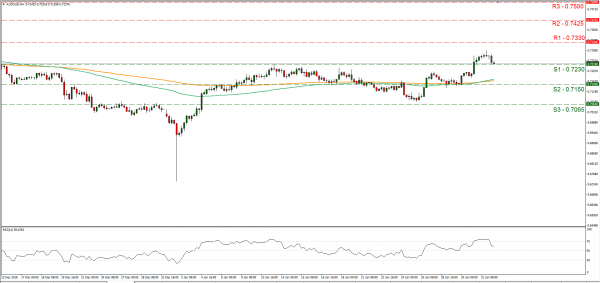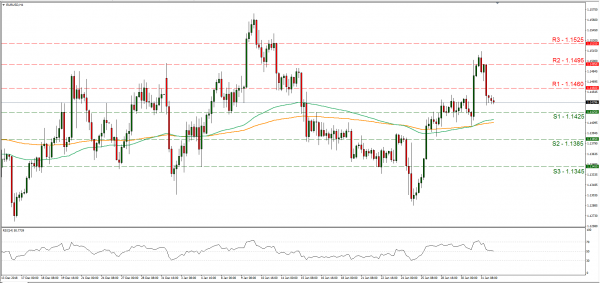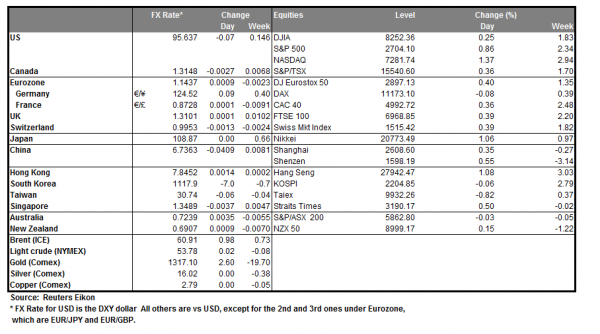Market focus today is expected to be on the release of the US employment report for January, with its NFP figure. Should the unemployment rate (3.9%) and the average earning s growth rate (+3.2% yoy) remain unchanged as forecasted, the spotlights will be on the NFP figure which is expected to drop to 165k, if compared to December’s 312k. As December’s figure is one of the highest in the past three years, it leaves the January NFP figure with little room for any advancement. Should the actual NFP figure indicate a higher reading in jobs created than the one expected, the market could perceive the readings as bullish for the USD as it could support the notion of the US labor market remaining tight. Should the NFP figure suffer a wider drop than expected though, due for example to the negative effect of the US shutdown, we could see the USD weakening. As analysed in yesterday’s report, EUR/USD dropped heavily yesterday, breaking the 1.1495 (R2) and the 1.1460 (R1) support lines (now turned to resistance). We see the case to continue to trade in a bearish market, as weak European financial data are expected to continue to reel in. However we expect the release of the US employment report for January to be a make or break point for the pair as under certain circumstances it could reverse the pair’s bearish direction. Should the pair continue to be under the market’s selling interest, we could see it breaking the 1.1425 (S1) support line and aim for the 1.1385 (S2). Should on the other hand the pair find extensive buying orders along its path, we could see it breaking the 1.1460 (R1) resistance line and aim for the 1.1495 (R2) resistance barrier.
Aussie weakens against USD on poor Chinese data
The Aussie weakened during today’s Asian session against the USD, after the Caixin Mfg PMI dropped to one of its lowest readings for three years. The contraction marked, have caused worries about a global slowdown to re-emerge, which could have also wider implications to other currencies. Never the less the broader risk sentiment remained rather stable, as per analysts, as US president Trump said on Thursday that he would meet with Chinese President Xi Jinping soon to try a seal a deal. Analysts point out that should a US-Sino trade deal be struck, we could see the risk sentiment getting a boost, causing the USD to weaken, at least temporarily. AUD/USD dropped during today’s Asian session, reversing the bullish direction of the past two days, testing the 0.7230 (S1) support line. We maintain a bearish outlook for the pair, yet the pair’s direction could be reversed from any positive headlines about the US-Sino trade relationships and the US employment report. Should the bears continue to dictate the pair’s direction, we could see the pair breaking the 0.7230 (S1) support line and aim for the 0.7150 (S2) support barrier. Should on the other hand the pair come under the bull’s influence, we could see it breaking the 0.7330 (R1) resistance line, aiming for higher grounds.
Today’s other economic highlights
In today’s European session, we get Germany’s final Mfg PMI for January, UK’s Mfg PMI for January and Eurozone’s preliminary CPI rate for January. In the American session (13:30,GMT) we get the US employment report for January as mentioned above and the US ISM Mfg PMI as well as final reading of the Michigan consumer sentiment, both for January. Last but not least in the Americans session, we get the Baker Hughes active oil rig count figure.
AUD/USD H4
Support: 0.7230 (S1), 0.7150 (S2), 0.7065 (S3)
Resistance: 0.7330 (R1), 0.7425 (R2), 0.7500 (R3)
EUR/USD H4
Support: 1.1425 (S1), 1.1385 (S2), 1.1345 (S3)
Resistance: 1.1460 (R1), 1.1495 (R2), 1.1525 (R3)


















